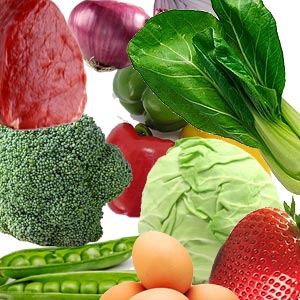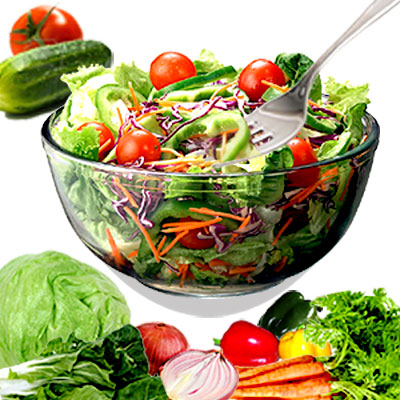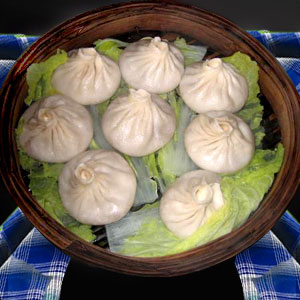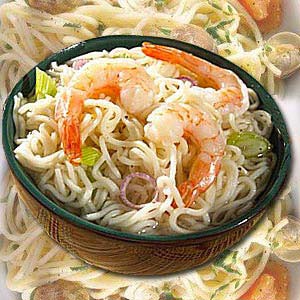Food Combining

Fries or mashed potatoes with Steak, Eggs on Toast and Shepherds pie! Read on to discover why these combinations of comfort foods are hard to digest and make us long for a siesta rather than providing us energy to get on with our demanding lives.
Food combining or trophology as it is lesser known, is being rediscovered and used as a key to wholesome nutrition. Food combining is the process of segregating different food groups (carbohydrates, fats and proteins) and eating them only in compatible combinations as required by our digestive mechanism.
Food combining and digestion
Digestion plays a vital role in helping our body extract and assimilate nutrients from the food we eat. Different digestive enzymes are secreted by our digestive system to digest different food groups. These enzymes are either
acidic or alkaline in nature.
Proper food interaction facilitates complete digestion as it respects the differences in digestive enzymes secreted by the body as well as the different time periods required for the digestion of various food groups. It is essential to understand the biochemistry of digestion to appreciate the concept of food combining. Two main rules of the thumb are:
- Foods with Proteins require an acidic environment so that they can be digested.
- Carbohydrates mainly sugars, starches and fruits require an alkaline environment to be digested
Wrongly combined foods - Their effect on digestion and overall health
When foods are combined and consumed inappropriately, digestive enzymes are unable to function effectively. This leads to accumulation of undigested food in the stomach, some of it passes out in feces, but the rest stays put in the digestive tract and decomposes. This decomposition creates conducive environment for yeast, bacteria, viruses and cancer cells to grow in your body.
These cause several disturbances in our system like intestinal gas, abdominal pain, dietary deficiencies due to lack of absorption of necessary nutrients. In severe cases, illnesses like chronic fatigue syndrome, Irritable Bowel Syndrome and obesity can also be contributed to indigestion.
Consider this example: When fruits and proteins are consumed together, both the acidic and the alkaline enzymes are stimulated and the opposing digestive juices are neutralized. This kind of situation often leads to indigestion; bloating and hinders the absorption of nutrients. It also delays the process and digestion and creates a backlog of undigested food in the stomach.
Food combining rules
Listed below are some rules to follow when combining foods to obtain optimum benefits of foods.
Fruits: They should never be combined with any other foods. The rationale being that fruits take very little time to digest when compared to other foods which take a while. Fruits do not get digested in the stomach and are held up if eaten with foods that require digestion in the stomach. If they are combined, they tend to partially digest and ferment which causes gas and bloating in our system. Caution should be exercised when combining fruits too.
- Fruits which contain acid (strawberries, pineapple and grapefruit) should not be eaten with fruit with too much sugar content in them. e.g.: bananas, raisins and dates.
- Fruits like melons should be eaten alone as they digest very quickly.
- Always remember that a fruit salad is healthy when fruits are combined appropriately and never after/with a meal.
- Fruits are best eaten on an empty stomach.
Proteins
- Foods which contain protein like lamb, pork or red meat should not be combined with starches or complex carbohydrates as they both require different mediums for digestion.
- Foods which contain proteins should not be combined with dairy products like milk. Ice-cream after a steak dinner is best avoided.
- It is beneficial to eat one kind of protein at a meal rather than a combination.
- Proteins are best eaten as a combination with green leafy vegetables and vegetables which do have minimum starch content. E.g. Carrots, leeks, onions etc.
- Do not combine any protein foods with acidic foods .e.g.: tomatoes and eggs. The acids secreted by the acidic foods hinder the secretion of the digestive acid required for digestion of protein foods.
- Eat nuts and proteins at separate meals as nuts have very large amounts of fat content ranging up to 50% in certain cases.
Food combining guidelines
- Ensure that desserts are avoided after a heavy meal as they take a long time to digest and tend to ferment soon.
- Ensure that liquids are consumed either an hour later or an hour after eating food as liquids dilute our digestive enzymes and hinder the process of digestion.
- Ensure that there is a gap of at least an hour between each meal to allow your body to digest and absorb your last meal.
- Avoid using more than three food groups in a combination and not more than one concentrated protein or starch at one meal.
- While combining fats and oil with foods, limited quantities need to be used as they could slow down the process of digestion.
Food combining and weight loss
Nutritionists believe that the concept of food combining aids in balancing body weight by enhancing our digestive system. This is in turn helps our body to absorb nutrients well and keep excess calories and unfriendly bacteria at bay. Several weight loss diets have been formulated on this theory. The important ones are listed below.
Hay diet: This diet is named after Dr.William Howard Hay who developed and introduced this concept way back in 1920. It works on the theory that right food should be provided to the body through food combining and all unwanted food that could hinder digestion should be removed or avoided.
Beverly Hills diet: This was developed by Judy Mazel. This diet usually lasts for six weeks .The followers of this diet advocate eating proteins and carbohydrates at different times based on food combining
Somersizing diet: This diet was developed television celebrity Suzanne Somers. This diet advocates limiting carbohydrate intake as well as maintaining emphasis on food combining.
Zone Diet: This diet based on food combining was developed and popularized by biochemist named Barry Sears. Proponents of this diet advocate consumption of calories from proteins, carbohydrates and fats in a balanced ratio.
Most of these diets encourage eating more fruits and vegetables which are essential for optimum nutrition. There could also be a rapid weight loss due to limits on the various foods allowed. However as with all diets, proper care should be taken to avoid becoming deficient in nutrients and going below the required calorific intake. It is always advisable to consult a physician before going on a diet.
Top of the Page: Food Combining
Tags:#food combining #food combining rules #food combining guidelines #food combining for weight loss
 Food and Nutrition Facts
Food and Nutrition Facts Chamomile
Parsnip Soup
Dim Sum
Gazpacho Soup
Whole Grain Cereal
Jicama Nutrition
Bok Choy Stir Fry
Chia Seeds Benefits
Teff Nutrition
Kaniwa
Flax Seed
Wheatgrass Benefits
Kelp Benefits
Types of Chili Peppers
Medicinal Benefits of Pomegranate
Arugula Leaves
Maca Root
Pitaya Fruit
Benefits of Celery
Leek
Asparagus Benefits
Oyster Stew
Oyster Mushroom
Lupin Beans
Quinoa
Freekeh
Extra Virgin Olive Oil
Dill Pickle
Sauerkraut
Fat Burning Foods
Nutrition Chart
Food Combining
Calorie Counter
calories ...
Non Alcoholic Beverage
Punch Recipes
Food Label Nutrition
Homemade Sausages
Cooking Steak
Eating on a Budget
Budget Friendly Recipes
Quick Recipes
 Healthy Packed Lunch
Healthy Packed Lunch Overnight Oats Recipes
Eggplant Casserole
Brunch Recipes
Burrito Recipes
Muffin Recipes
Cupcake Frosting
Apple Crisp
Stir Fry Cooking
Seafood Salad Recipe
Cooking Corn on the Cob
Finger Food Recipe
Sandwich Recipe
Bread Stuffing Recipes
Easy Chili Recipes
Picnic Recipes
Edible Mushroom Recipes
Mushroom Soup Recipes
Dip Recipe
Tapas Recipe
Corned Beef Recipe
Canned Salmon Recipe
Tilapia Recipes
Crumb Cake
Flourless Chocolate Cake
Regional Food
 Lasagna Recipe
Lasagna Recipe Peruvian Ceviche
Chinese Food Recipe
Vietnamese Food Recipe
Malaysian Food
Korean Food Recipe
Indian Curry Recipe
Edible Rice Paper
Mexican Food Recipe
Quesadilla
Guacamole Dip
Italian Food Recipe
Spanish Food Recipe
Kosher Food
Falafel Recipe
Tandoori Chicken
Noodles
Canape
Couscous
Meatloaf
Chowder
Gumbo Recipe
Crockpot Recipes
Moroccan Food
Healthy Food
Pre Workout Snack
Matcha Tea
Simple food Swaps to Lose Weight
Foods to Beat Stress
Foods to beat Insomnia
Bone Density Foods
Prebiotic Foods
Kefir Grains
Agave Nectar
Spicy Trail Mix
Pesto Sauce
Homemade Hummus
Crab Cake Sauce
Bamboo Shoots Nutrition
Lemon Grass Plant
Butter Beans Recipes
Loose Green Tea
Seaweed Nutrition
Healthy Food
Low Fat Granola Bar
Steel Cut Oatmeal
Fruit Pizza
Pizza Toppings
Green Smoothie
Healthy Meal Planning
Delicious Mealtime Recipes
Heart Healthy Fats
Healthy Heart Recipe
Healthy Dinner Recipe
Healthy Dessert Recipe
Healthy Fast Food
Healthy Kid Recipe
Probiotic Food
Diabetic Friendly Foods
Fruit Salad Recipe
Bread Pudding
Tofu Recipe
Oat Bran
Broccoli Salad
Avocado Recipe
Iron Rich Food
Brain Foods
Antioxidant Food
Natural Diuretic
Low Fat Cooking Tips
Rice Pilaf Recipe
Low fat Chicken Recipe
Food Tips

Sous Vide Cooking Technique
Natural Sugar Substitute
Stevia Sugar Substitute
Sunflower Seeds Nutrition
Bouquet Garni
Cake Decorating Tips
High Satiety Foods
Thanksgiving Dinner
Safe Food Storage
Frozen Food Storage Tips
Cold Storage Food Tips
Leftover Recipe
Food Pyramid
Dairy Free Food
Microwave Cooking
Food Intolerance
Homemade Ice Cream
Apple Cider Vinegar
Benefits of Honey
Beverage Cooler
Food Poisoning Symptom
Food Allergy Symptom
Food Addiction
Top of the Page: Food Combining
Popularity Index: 100,894

